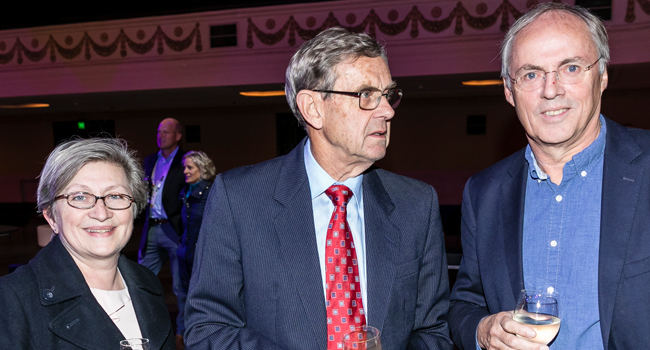14 Aug 2018
Organoids Are Us
Organoids Are Us was a one-day symposium to highlight the game-changing advances to science and medicine that are the direct result of more than 30 years of fundamental research into the Wnt signalling pathway.
Symposium organisers, the Doherty Institute’s Professor Elizabeth Vincan and the Walter and Eliza Hall Institute’s Dr Maree Faux.

Professor Elizabeth Vincan, Professor Tony Burgess, Walter and Eliza Hall Institute, head of ALOA and Professor Hans Clevers who established the HUB, a not-for-profit living organoid Biobank in the Netherlands.
This symposium follows on from the first European Molecular Biology Organization (EMBO) workshop on Wnt signalling held in Australia, at Cable Beach, Broome in 2014.
Wnt signalling is an ancient cell-cell communication pathway that is conserved though evolution and tells the cells of our body what to be, where to go and what to do. It plays an important role during embryonic development, and maintains normal tissue function in the adult.
However, inappropriate activation of the pathway leads to diverse human diseases including cancer.
Leaders in the Wnt field delivered talks on advances in stem cell (Dr Karl Willert, Professor Nick Barker and Professor Arial Zeng) and cancer (Professor David Virshup and Dr Ram Dasgupta) fields.
Elizabeth Vincan opened the first session with a symposium overview and a summary of her team’s research into the role of ‘Frizzled 7’ in the gastrointestinal tract and her laboratory’s more recent work on establishing an organoid platform for studying infectious disease.
A game-changing advance spawned by the Wnt field is organoid technology – more specifically, tissue-restricted adult stem cell derived organoids.
This advance was led by the Clevers Group from the Hubrecht Institute for Developmental Biology and Stem Cell Research in the Netherlands, who worked out a way to coerce adult tissue stem cells to do in tissue culture what they do in the body i.e. make tissue.
These mini-replicas of tissues, termed ‘organoids’, meaning “organ-like”, can be readily manipulated, genetically or pharmacologically, to understand what makes a stem cell be a stem cell, and what changes occur in a normal stem cell to make them become cancer cells.
Furthermore, organoids can be established from patient-derived tumours for anti-cancer drug pre-screening. The response of the tumour organoids to drug treatment matches the response of the patient to therapy.
Thus, we can truly personalise therapy and avoid unnecessary treatment. In his plenary talk for the symposium, Professor Clevers said that clinicians in Europe now order an organoid test, which forms an integral part of their diagnosis and treatment decision.
Organoid testing is also applicable to conditions with a defined genetic cause, such as cystic fibrosis. Australia is well on the way to introducing similar organoid-based testing (see Australian Living Organoid Alliance, ALOA).
The new frontier for organoid technology is organoids as models of infectious disease. The organoids faithfully recapitulate the key features and function of the intact tissue e.g. cell types present and tissue architecture, making them innovative models of natural infection, enabling the study of diverse human viruses that until now lacked suitable cell culture or animal models.
Dr Mike Catton, Director of the Victorian Infectious Diseases Reference Laboratory (VIDRL) at the Doherty Institute said that organoid culture is an “innovative advance for virology, for fundamental research and public health”.
The Doherty Institute is perfectly placed to advance this field, given the multi-disciplinary groups (VIDRL, Epidemiology, Department of Microbiology and Immunology, Royal Melbourne Hospital laboratories etc) all housed in the one Institute.
The symposium was attended by 400 delegates from diverse backgrounds and was generously supported by STEMCELL Technologies, Perkin Elmer, Geneworks, Thermo Fisher Scientific and VIDRL.
Huge thanks to Susan Northfield (University of Melbourne’s Therapeutic Technologies Research Initiative), Patricia Gigliuto (Centre for Stem Cell Systems, University of Melbourne), Helen Braybrook (Stem Cells Australia), Finian Scallan (Doherty Institute); and Jean Moselen, Renate Schwab and Bang Tran (Vincan Laboratory, Doherty Institute) for their invaluable help with organising this event.


